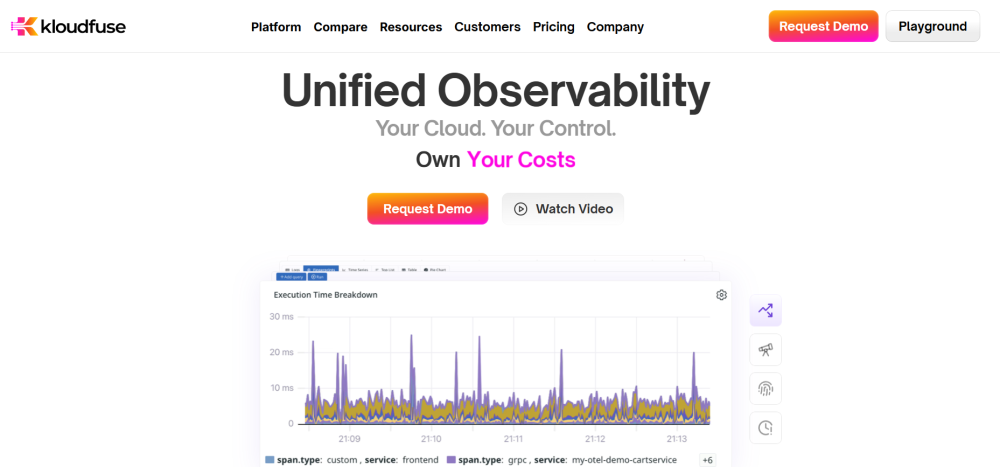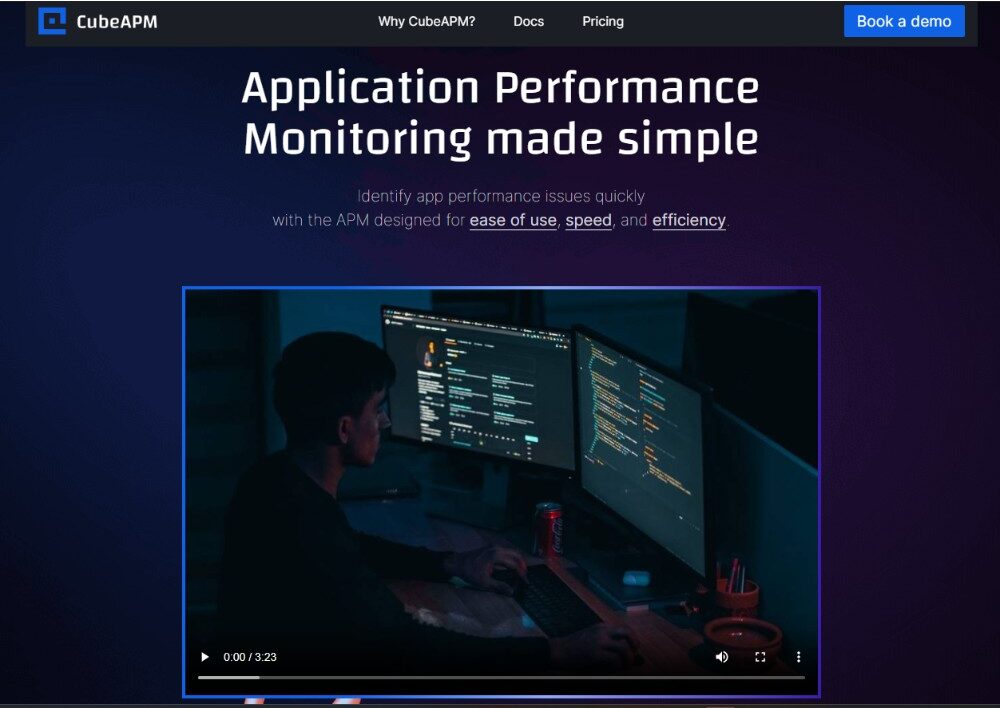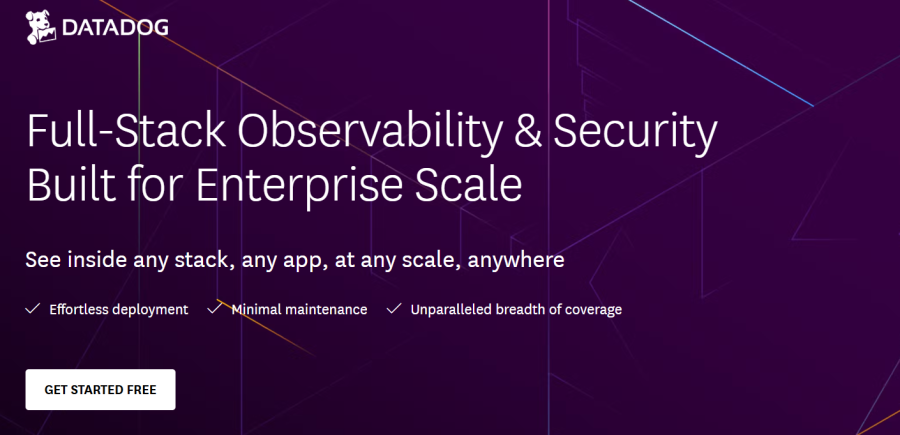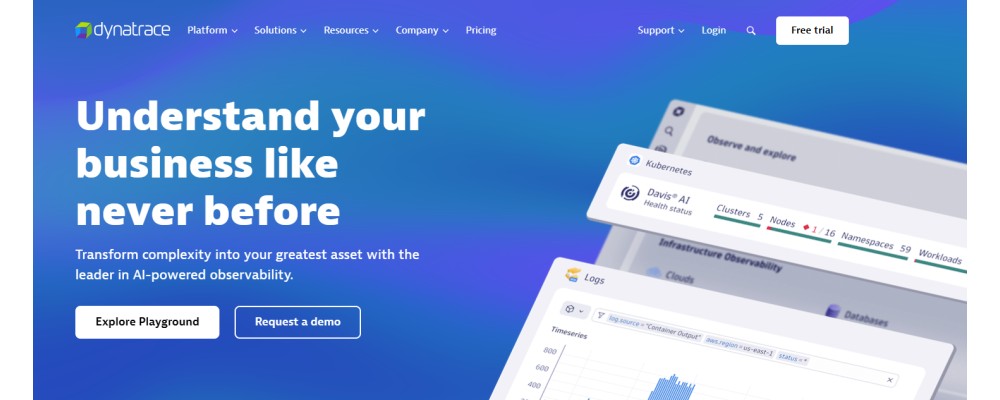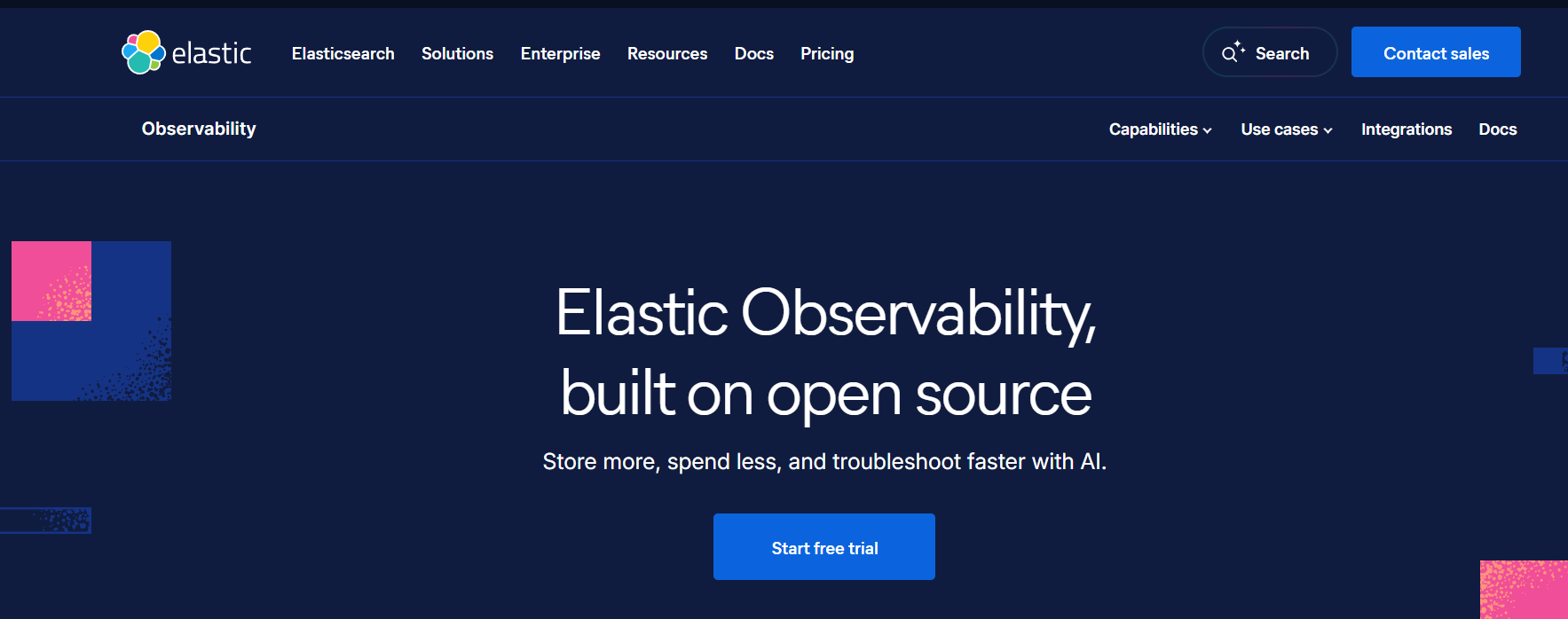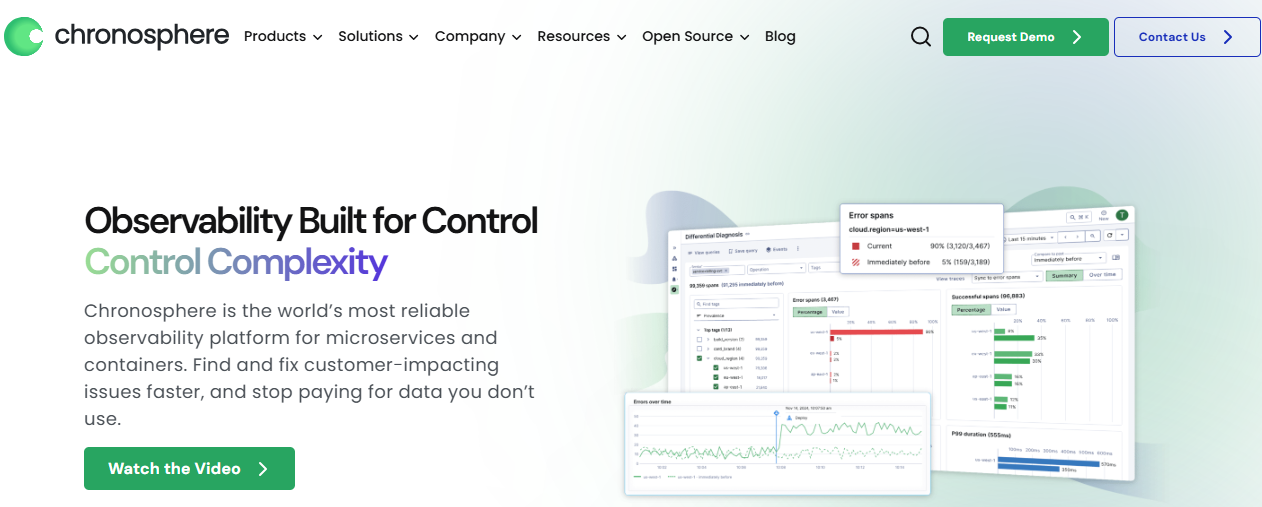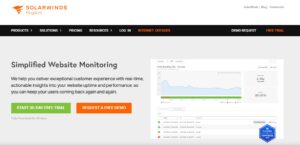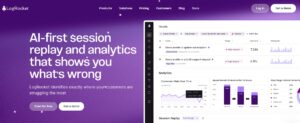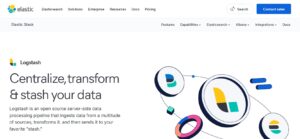Kloudfuse is a modern observability platform that unifies metrics, logs, traces, real-user monitoring (RUM), and continuous profiling. As the global APM and observability market is valued at US$9.5 billion, scalable platforms that simplify monitoring in complex, cloud-native environments are in demand.
But Kloudfuse’s self-SaaS, VPC-only model can introduce operational overhead, requiring teams to manage scaling, upgrades, and control planes. Flat pricing reduces unpredictability, but high-volume or high-cardinality workloads may still escalate storage and compute costs if not optimized.
CubeAPM is the best Kloudfuse alternative as it delivers unified metrics, logs, traces, RUM, and error tracking, smart sampling, OpenTelemetry-native ingestion, flat $0.15/GB pricing, and instant Slack/WhatsApp support.
In this article, we’ll cover seven Kloudfuse alternatives based on integrations, pricing, deployment models, scalability, and analytics.
Table of Contents
Toggle7 Best Kloudfuse Alternatives
- CubeAPM
- Datadog
- New Relic
- Dynatrace
- Elastic Observability
- Chronosphere
- Grafana
Why Look for Kloudfuse Alternatives?
Operational Overhead: VPC-Only/BYOC Deployment
Kloudfuse runs via a Self-SaaS/BYOC model—in your Kubernetes VPC—which offers data privacy and no vendor lock-in, but comes with operational responsibilities. You need to manage the control plane, cluster lifecycle, scaling, backups, and upgrades yourself. For small to mid-size DevOps teams, this can divert resources away from core engineering goals. Fully SaaS alternatives eliminate this overhead by handling operations, keeping internal focus on product rather than infrastructure.
Pricing Transparency & Budgeting Difficulties
Kloudfuse promotes “flat, predictable pricing,” but it does not publish exact rates. Instead, customers must request a tailored quote based on volume tiers (S, M, L, XL, XXL). While the model removes per-user and egress fees, finance teams often struggle to predict Total Cost of Ownership (TCO) without transparent per-GB pricing.
Pricing example (10 TB/month)
- CubeAPM: Public list price $0.15/GB → $1,500/month for 10,000 GB. Flat ingestion pricing; no per-host/per-user fees.
- Kloudfuse: Pricing is quote-based and deployed in your cloud, so total monthly spend = license + your cloud infra (compute/storage). No public per-GB figure is published; you must request a TCO quote. (Thus, an apples-to-apples numeric total isn’t publicly verifiable.)
Cost Concerns with Unsampled Ingestion
Kloudfuse processes 100% of events unsampled—ideal for fidelity, but potentially costly at scale. Though they offer optimizations like log fingerprinting, aggregation, deduplication, and rate controls, ingesting massive volumes can still inflate storage and infrastructure costs, particularly in high-cardinality, microservices-heavy environments. Alternatives offering dynamic sampling (e.g., tail-based) provide more cost control for ultra-high-volume scenarios.
Migration & Ecosystem Friction
Although Kloudfuse supports OpenTelemetry, Prometheus, and open query languages (PromQL, LogQL, TraceQL), transitioning from other SaaS observability tools can still require significant effort. Teams must rebuild dashboards, alerts, and workflows. Some competing products offer smoother onboarding with prebuilt dashboards, migration scripts, or one-click integrations, reducing friction and adoption time.
Criteria for Selecting Kloudfuse Alternatives
Full MELT Coverage
Any viable alternative should provide comprehensive metrics, events, logs, and traces (MELT) in a unified platform. This ensures that engineers can pivot from high-level SLO breaches down to granular logs and traces without switching tools. Some solutions also add Real User Monitoring (RUM) and continuous profiling, which help connect backend health to frontend experience.
Native OpenTelemetry and Open Standards
Kloudfuse is OTel-native, and alternatives should match this openness. Look for seamless ingestion via the OTLP protocol, Prometheus metrics scraping, and compatibility with query languages like PromQL, LogQL, and TraceQL. OTel-native design reduces lock-in, simplifies instrumentation, and future-proofs observability pipelines.
Deployment Model Flexibility
Kloudfuse runs inside customer VPCs (BYOC/Self-SaaS), which suits compliance-heavy industries but demands internal operations. Alternatives should offer deployment flexibility—fully managed SaaS, on-prem, hybrid, or BYOC options—so organizations can balance control, compliance, and operational simplicity.
Sampling and Cost Controls
Unsampled ingestion, Kloudfuse’s default, guarantees visibility but can be costly at scale. Alternatives should offer tail-based or dynamic sampling, retention controls, and high-cardinality optimization. These features give teams flexibility to manage both fidelity and cost efficiency.
Transparent Pricing and TCO Clarity
One of Kloudfuse’s drawbacks is quote-based pricing. When comparing alternatives, prioritize vendors with published, predictable rates or calculators that clearly show ingestion, storage, and retention costs. For example, CubeAPM’s $0.15/GB pricing translates to $1,500/month for 10 TB—a transparent benchmark that makes TCO planning easier.
AI-Driven Insights and SLO Management
As systems scale, raw dashboards aren’t enough. Alternatives should include AI/ML anomaly detection, root-cause analysis, and SLO tracking. This ensures faster mean time to resolution (MTTR) and connects observability metrics to business impact.
Ecosystem Maturity and Community Validation
Enterprises often prefer platforms with extensive third-party reviews, reference customers, and active communities. These signals validate stability, scalability, and vendor reliability. Lack of ecosystem validation increases adoption risk.
Support and Migration Assistance
Effective support goes beyond email. Alternatives should provide multi-channel SLAs (Slack, PagerDuty, OpsGenie, Teams), migration guides for OTel collectors, and dashboard/playbook libraries to reduce time-to-value during onboarding.
Kloudfuse Overview
Known for
Kloudfuse is known for being a unified observability platform that runs inside your own VPC. It consolidates metrics, events, logs, traces, real user monitoring (RUM), and continuous profiling into a single observability data lake. Its main use case is helping engineering and SRE teams achieve end-to-end visibility with flat, predictable pricing and no egress fees, while maintaining full control over their telemetry data.
Standout Features
- Unsampled event ingestion: Processes 100% of events in real time to avoid blind spots.
- Log fingerprinting: Patented feature to deduplicate logs, reduce noise, and cut storage costs.
- BYOC deployment: The tool can run in your K8 VPC, which helps with data residency as well as compliance.
- K-Lens AI insights: Provides anomaly detection, log clustering, and faster root-cause analysis.
Key Features
- Full MELT: Kloudfuse covers all observability elements, which are metrics, events, logs, traces, RUM, and profiling.
- OpenTelemetry-native: Built on OTel standards, supports PromQL, LogQL, TraceQL, GraphQL, and SQL queries.
- Digital Experience Monitoring (DEM): Real User Monitoring and Session Replay are tightly correlated with backend traces.
- Application Performance Monitoring: Service maps, RED metrics, distributed tracing, and SLO tracking.
- Integration ecosystem: 700+ data sources supported out of the box.
- Data optimization: Aggregation, deduplication, compression, and retention policies to manage high-cardinality telemetry.
Pros
- Full MELT observability in one platform
- OTel-native ingestion with open query support
- No egress fees or per-user charges
- Strong AI/ML insights with anomaly detection
- Runs in your own VPC for compliance control
Cons
- Quote-based pricing lacks transparency
- BYOC/VPC deployment adds operational overhead
- Limited independent reviews on G2 and Gartner
- Unsampled event ingestion can drive up costs at scale
Best for
Kloudfuse is best for enterprises that prioritize compliance, data residency, and predictable billing, particularly those with sensitive workloads in finance, healthcare, or government. It suits DevOps and SRE teams comfortable managing Kubernetes-based deployments and want the benefits of unsampled observability and AI-driven troubleshooting without vendor lock-in.
Kloudfuse Pricing & Customer Reviews
- Pricing: Exact pricing is not disclosed, but uses a tiered bucket model (S, M, L, XL, XXL) without per-user or egress fees.
- Gartner Peer Insights: 4.4/5
- Praised for: Strong compliance-friendly design, unified MELT platform, and patented log fingerprinting.
- Criticized for: Lack of transparent public pricing and operational overhead of BYOC deployment.
Top 7 Kloudfuse Alternatives
1. CubeAPM
Known for
CubeAPM is known for being an OpenTelemetry-native observability and APM platform designed for modern cloud-native teams. It brings together logs, metrics, traces, real user monitoring, synthetics, and error tracking, giving teams a practical way to monitor applications and infrastructure without juggling multiple tools.
Standout Features
- Smart sampling engine: Focuses on high-value traces—like those linked to latency spikes or errors—helping teams reduce noise while keeping critical data.
- Self-hosting option: Lets organizations deploy CubeAPM inside their own infrastructure, making it easier to meet strict compliance or residency requirements.
- Direct engineer support: Customers get access to Slack and WhatsApp channels with CubeAPM’s core engineers, cutting response times to minutes instead of days.
Key Features
- OpenTelemetry-first: Fully compatible with OTel agents and collectors for smooth data ingestion.
- Full MELT coverage: Metrics, events, logs, traces, RUM, synthetics, and error tracking covered in one platform.
- Prometheus support: Natively scrapes Prometheus metrics to unify infrastructure and application monitoring.
- Unified analytics: Correlates traces, logs, and metrics to speed up root-cause analysis and reduce downtime.
- Extensive ecosystem: Works with more than 800 popular cloud, DevOps, and infrastructure tools.
Pros
- Comprehensive MELT coverage out of the box
- Smart sampling helps teams control telemetry growth
- Deployment flexibility with SaaS or on-prem options
- Highly responsive customer support through chat channels
- Over 800 integrations with cloud, DevOps, and monitoring tools
Cons
- Less suitable for teams that prefer fully vendor-managed SaaS-only options
- Focused strictly on observability; does not extend into cloud security management
Best for
CubeAPM is best for teams that want cost predictability, strong OpenTelemetry support, and responsive support without heavy operational overhead. It fits well for mid-sized to large companies modernizing their observability stack or moving away from expensive legacy platforms.
CubeAPM Pricing & Customer Reviews
- Pricing: Flat $0.15/GB ingestion with no per-user, host, or egress fees
- Rating: 4.7/5
- Praised for: Simple onboarding, predictable costs, and excellent hands-on support
CubeAPM vs Kloudfuse
Kloudfuse gives teams full control by running inside their own VPC with unsampled data ingestion. CubeAPM, on the other hand, emphasizes ease of adoption and cost-optimized monitoring. With smart sampling, SaaS and on-prem choices, and a broader integration library, CubeAPM is often preferred by teams looking for flexibility and simplicity without losing enterprise-grade observability.
2. Datadog
Known for
Datadog is known for its broad, SaaS-based observability platform that spans infrastructure monitoring, APM, log management, RUM (web + mobile), synthetics, error tracking, profiling, and more—tightly connected by 900+ vendor-backed integrations for cloud and application stacks. It’s a popular choice for teams that want deep visibility without managing their own observability infrastructure.
Standout Features
- AI-assisted troubleshooting: Issue Correlation, Automated Analysis, and Bits AI help surface root causes and actions faster across telemetry.
- Full-fidelity tracing with code-level detail: Thread-level distributed tracing correlates with logs, infrastructure, databases, and frontend telemetry for faster RCA.
- Frontend experience visibility: RUM for web and mobile, plus Session Replay and Product Analytics to connect user journeys with backend performance.
Key Features
- Infrastructure monitoring: Coverage for hybrid, multi-cloud, containers, and serverless with 900+ integrations and tag-based analytics.
- Log management: Logging without Limits™—ingest, archive, and selectively index logs to balance cost and searchability.
- Synthetics & testing: API, browser, and mobile tests with global locations; CI visibility and multistep flows.
- Error tracking: Datadog groups identical errors for web, mobile, and backend with rate controls and fingerprinting.
- RUM-to-trace correlation: Link user sessions to backend traces to pinpoint UX-impacting backend problems.
Pros
- Extremely broad product coverage across observability and security
- Mature APM and infrastructure capabilities with deep integrations
- Strong web and mobile RUM with Session Replay and product analytics
- Powerful automation and AI features announced at DASH 2025
- Robust documentation and enterprise ecosystem
Cons
- Pricing can be complex and multi-dimensional across hosts, spans, logs, RUM, and synthetics
- Cost control requires careful tuning of custom metrics, indexed logs, and span indexing
- New users may feel a learning curve due to too many products
Best for
Datadog is best for teams that want a fully managed, feature-rich observability suite with strong APM, logging, and frontend monitoring—especially organizations that prefer SaaS delivery, operate at multi-cloud scale, and can invest time in cost governance (custom metrics, log indexing, span ingestion) to keep spend under control.
Datadog Pricing & Customer Reviews
- Pricing: $15–$31 per host/month (annual)
- G2 rating: 4.4/5
- Praised for: Rich feature depth across APM, infra, logs, and RUM; extensive integrations; strong alerting and dashboards.
- Criticized for: Complex, usage-based pricing and unpredictable bills—especially host-based APM, custom metrics overages, and paying to both ingest and index logs.
Datadog vs Kloudfuse
Datadog offers a hosted, all-in-one platform with expansive features and 900+ integrations—minimal ops burden compared with Kloudfuse’s BYOC/VPC model. Kloudfuse appeals where data-residency control and unsampled ingestion are priorities; Datadog suits teams that want SaaS convenience and deep product breadth, provided they actively manage cost levers like custom metrics, indexed logs, and span ingestion.
3. New Relic
Known for
New Relic is known for its usage-based, SaaS observability platform that spans APM, infrastructure monitoring, logs, browser and mobile RUM, synthetics, error tracking, and more—tied together with extensive integrations and an opinionated workflow around APM 360, Transaction 360, and Pathpoint for business observability.
Standout Features
- eAPM + OTel choice: Instrument services with no-code eAPM for Kubernetes or bring your own OpenTelemetry—whichever fits your pipeline.
- Pathpoint business journeys: Map technical health to customer and revenue journeys so ops can prioritize what truly matters.
- Front-end depth (web + mobile): Core Web Vitals, session replay, and crash analytics connect real user experience to backend performance.
Key Features
- APM 360 & distributed tracing: Code-level visibility, golden metrics, dependency maps, and trace correlation to speed up RCA.
- Infrastructure monitoring: Hybrid and multi-cloud coverage with inventory, change events, and tag-driven analytics.
- Log management with AI: the tool collects logs and offers fast search and AI-based triaging.
- Synthetics: Global API and browser checks, private locations, and scripted flows for critical transactions.
- Errors Inbox: New Relic offers features, such as fingerprinting, error grouping, and Slack workflows, so you can consolidate error triaging for different systems.
- Integrations: 780+ supported quickstarts and integrations to accelerate setup.
Pros
- Mature APM with strong traces, errors, and dependency insights
- Robust browser and mobile RUM plus session replay
- Flexible data ingest model with a generous free tier starter
- eAPM and OpenTelemetry support to match different instrumentation styles
- Wide ecosystem with hundreds of integrations
Cons
- Costs can rise with data ingest and full-platform user licenses at scale
- Log/trace must be indexed to save on bills
- Overwhelming features may create a learning curve
Best for
New Relic is best for teams that want a full-featured, hosted observability suite with deep APM and strong front-end/mobile capabilities, and that are comfortable adopting usage governance (sampling policies, retention rules, and user tiering) to keep spend predictable while scaling across multi-cloud environments.
New Relic Pricing & Customer Reviews
- Pricing: 100 GB/month free ingest; paid: $0.40/GB-$0.60/GB (Data Plus) or $49/user/month-r$418.80/user/month
- G2 rating: 4.4/5
- Praised for: Excellent APM and tracing, many integrations, and deeper RUM.
- Criticized for: Pricing complexity at scale and a learning curve when rolling out across many teams.
New Relic vs Kloudfuse
New Relic provides a fully hosted, usage-priced platform with rich APM and front-end/mobile features and 780+ integrations—ideal if you want minimal ops overhead and strong UX analytics. Kloudfuse is better if you want BYOC/VPC control and ingestion without sampling, but New Relic is more preferable if you want SaaS convenience and ingest control to lower bills.
4. Dynatrace
Known for
Dynatrace is known for its AI-powered, hosted observability platform that unifies application and infrastructure monitoring, log analytics, digital experience, and business observability. Its Davis® AI, Smartscape® topology, Grail™ data lakehouse, AppEngine, and AutomationEngine work together to automate discovery, root-cause analysis, and remediation at enterprise scale.
Standout Features
- Davis AI: This AI offers predictive, causal, and generative AI for efficient RCA, forecasting business impact, and recommending fixes.
- Grail: This data lakehouse offers schema-on-read storage without indexing to retain data context for better analytics.
- Smartscape + PurePath: Automatic service and dependency mapping with end-to-end distributed traces and code-level context to shrink MTTR.
Key Features
- APM: Offers APM with SLOs, code-level profiling, OTel support, and analytics, which is great for tech stacks that are cloud-native.
- Infra observability: Dynatrace covers hybrid as well as multi-cloud environments with constant issue discovery and AI insights.
- Digital experience: Real-user monitoring with session replay and synthetic tests to tie UX issues to backend services.
- Log management & analytics: OpenPipeline processing, contextual logs-in-traces, and AI copilots—no index management required.
- Business observability: Business events in Grail, KPI tracking, and cost/carbon optimization to connect tech health to outcomes.
- Kubernetes platform monitoring: Pod/node insights, low-privilege collection, and AI root cause for cluster issues.
Pros
- Powerful AI-assisted root-cause analysis and automation
- Unified data context via Grail with topology awareness
- Automated discovery and tracing through OneAgent and Smartscape
- Strong RUM, session replay, and synthetics for customer-journey insight
- Broad enterprise ecosystem, apps, and integrations
Cons
- Usage-based model spans multiple meters and needs active cost governance
- Learning curve because of so many features available
- Vendor-hosted SaaS may not suit organizations requiring strict in-VPC/BYOC control
Best for
Dynatrace is best for enterprises operating complex, distributed environments that want AI-driven answers, automation, and tight correlation across applications, infrastructure, logs, and user experience. Teams with mature FinOps/usage governance get the most value, especially when they standardize on Dynatrace for both observability and business analytics.
Dynatrace Pricing & Customer Reviews
- Pricing: $0.08/hr/8 GiB host for full-stack IT observability.
- G2 rating: 4.5/5 (Observability/Monitoring categories, 2025 snapshot).
- Praised for: AI-precision RCA, automated discovery, rich RUM/replay, and enterprise-grade scale and reliability.
- Criticized for: Cost complexity across meters without strong governance and a non-trivial learning curve for first-time teams.
Dynatrace vs Kloudfuse
Dynatrace delivers a hosted, AI-forward platform with a transparent rate card and extensive capabilities across APM, infra, logs, UX, and business analytics. Kloudfuse offers BYOC/VPC deployment with quote-based pricing. If you need SaaS convenience, deep AI automation, and integrated business context, Dynatrace has the edge; if you require strict in-VPC residency with predictable flat tiers, Kloudfuse is compelling.
5. Elastic Observability
Known for
Elastic Observability is known for its search-powered, open, and extensible observability platform built on the Elastic Stack (Elasticsearch + Kibana). It unifies logs, metrics, traces, RUM, synthetics, infrastructure, and APM—now with serverless delivery and AI assistance—to help teams troubleshoot quickly while keeping costs predictable.
Standout Features
- Serverless with ingest-based pricing: Elastic Observability Serverless charges “pay only for what you use” with clear per-GB rates for ingest and retention, plus optional add-ons like synthetics and an Elastic-managed LLM.
- Search AI Lake + AI Assistant: A Search-AI-Lake architecture and an AI assistant help correlate MELT data and speed root-cause analysis without heavy index management.
- OpenTelemetry-first: Native OTel ingest (metrics, traces, logs) and Elastic Distributions of OpenTelemetry (EDOT) give flexible instrumentation paths.
Key Features
- APM with distributed tracing: End-to-end tracing, code-level visibility, mobile APM, and LLM/GenAI app monitoring options.
- Infrastructure monitoring: Coverage across clouds and platforms with out-of-the-box ML, dashboards, and 200+ integrations.
- Log monitoring & analytics: High-cardinality log analysis with fast search, alerting, and retention controls.
- Digital experience monitoring: Real User Monitoring and Synthetics connect frontend experience to backend services.
- Docs and quickstarts: Guided docs and quickstarts to accelerate setup and operations.
Pros
- OpenTelemetry-native with flexible instrumentation
- Strong logs + search capabilities at scale
- Serverless option with clear ingest/retention pricing
- RUM and Synthetics tie UX to backend health
- Large ecosystem and steady enterprise adoption
Cons
- Learning curve for teams new to Elastic and Kibana
- Cost still requires governance for very high data volumes
- Some teams prefer more opinionated, out-of-the-box APM workflows
Best for
Elastic Observability is best for engineering organizations that value openness and search-driven analytics, want OTel-native ingest, and prefer transparent per-GB economics. It’s a strong fit if you already use the Elastic Stack, need flexible retention/ingest controls, or want to start serverless and grow into broader enterprise features over time.
Elastic Observability Pricing & Customer Reviews
- Pricing: Serverless Logs Essentials: as low as $0.105/GB ingested, $0.018/GB-month retention; Serverless Complete (full-stack MELT + SLOs, ML/AIOps, AI Assistant): as low as $0.150/GB ingested, $0.020/GB-month retention; egress 50 GB free, then $0.05/GB. Optional add-ons include synthetic browser tests at $0.0123/test, lightweight ping locations $28/location/month, and Elastic-managed LLM ($4.50/M input tokens, $21/M output tokens). Support is tiered as a percentage of consumption.
- G2 rating: 4.2/5
- Praised for: Powerful log search and analytics, OTel-friendly ingest, flexible pricing options including serverless.
- Criticized for: Steeper learning curve for new users and the need to actively manage data volume to control cost.
Elastic Observability vs Kloudfuse
Elastic provides SaaS/serverless convenience, OTel-native ingest, and transparent per-GB rates with optional add-ons; Kloudfuse emphasizes BYOC/VPC control and unsampled ingestion with flat, quote-based tiers. If you want open standards with search-driven analytics and clear list pricing, Elastic is compelling; if strict in-VPC residency and full-fidelity ingestion are must-haves, Kloudfuse remains attractive.
6. Chronosphere
Known for
Chronosphere is known for its control-first, SaaS observability platform built for Kubernetes and microservices at scale. It combines high-volume metrics, distributed tracing, logs, and change events with data-shaping and cost controls, plus a managed telemetry pipeline rooted in open standards like Prometheus, OpenTelemetry, and Fluent Bit.
Standout Features
- Dynamic trace control: Tail and head sampling you can turn up during incidents and dial back afterward—without redeploying—so you capture the right spans when it matters.
- Change Event Tracking: Correlates deployments, config changes, and incidents in real time so engineers can see “what changed” at the exact moment performance dipped.
- Telemetry Pipeline built on Fluent Bit: Vendor-agnostic collection and transformation with multi-destination routing and in-flight cost optimization.
Key Features
- Metrics at scale: Prometheus-compatible ingestion, high-cardinality handling, SLOs, and topology views for containerized environments.
- Distributed tracing: DDx (Differential Diagnosis) workflow, topology, live trace analyzer, and trace-to-metric conversion for alerting. 100% compatible with OTel, Jaeger, and Zipkin.
- Log management: Two-part model (Processing vs. Persistence) to separate ingest from what you choose to store; KQL-style querying and utility scoring to reduce noise.
- Open source & standards: First-class support for OpenTelemetry collectors and Prometheus, plus guidance and programs around key OSS projects.
- Cost governance: Usage profiling, drop/aggregate rules, quotas, and recommendations to curb low-value telemetry before it drives spend.
Pros
- Strong cost controls for high-cardinality metrics and tracing
- Incident workflows (DDx, topology, change overlays) speed RCA
- Open standards compatibility reduces vendor lock-in
- More focus on K8 and claims higher uptime (99.99%)
- Telemetry Pipeline simplifies complex multi-dest routing
Cons
- Public per-unit pricing not listed; sales-assisted quotes are typical
- Learning curve if teams are new to Prometheus/PromQL patterns
Best for
Chronosphere is best for cloud-native engineering orgs that need to rein in exploding telemetry volumes without losing critical signals—especially teams standardizing on Prometheus and OpenTelemetry and operating large Kubernetes fleets where cost governance, dynamic sampling, and incident speed matter.
Chronosphere Pricing & Customer Reviews
- Pricing: Quote-based. Logs use a two-component model—Processing (ingest) and Persistence (retained storage)—to align spend with value; the platform offers quotas, utility scoring, and recommendations for data reduction.
- G2 rating: 4.5/5
- Praised for: Cost control features, Prometheus compatibility, supportive onboarding, and ongoing guidance.
- Criticized for: Need for governance to avoid cardinality blowups and a learning curve for teams new to PromQL.
Chronosphere vs Kloudfuse
Kloudfuse offers BYOC/VPC deployment, no ingestion sampling, and data residency. Chronosphere offers a SaaS model with aggressive cost-governance levers—dynamic trace sampling, log Processing vs. Persistence, and a Fluent Bit–based pipeline—geared to keep signal high while curbing waste. If your priority is in-VPC control and full-fidelity storage, Kloudfuse fits; if you want managed operations and powerful data-shaping to control spend at scale, Chronosphere is compelling.
7. Grafana
Known for
Grafana (self-managed) is known for its open-source visualization and observability UI that connects to dozens of data sources and powers rich, real-time dashboards. When paired with the LGTM stack—Loki for logs, Grafana for visualization, Tempo for traces, and Mimir/Prometheus for metrics—it becomes a flexible, DIY observability layer you can run on your own infrastructure.
Standout Features
- Open plugin ecosystem: Hundreds of official and community data source plugins—Prometheus, Loki, Elasticsearch, CloudWatch, PostgreSQL, and more—so teams can centralize telemetry without vendor lock-in.
- Unified alerting: Grafana Alerting defines rules across multiple sources and routes notifications to Slack, PagerDuty, Opsgenie, email, and more with templating and silencing.
- LGTM stack ready: Natively visualizes Loki/Tempo/Mimir so you can overlay logs, traces, and metrics in one place with consistent labels and drill-downs.
Key Features
- Dashboards & panels: Highly customizable dashboards, transformations, variables, and panels for time series, logs, traces, and business KPIs.
- Annotations & correlations: Timeline overlays for deploys and incidents, plus panel-to-panel linking to follow an investigation path.
- Role-based access (Enterprise): Granular permissions, reporting, and enterprise plugins for data governance at scale.
- Provisioning & as-code: Manage dashboards, datasources, and alert rules through code for repeatable environments.
- Ties into OSS backends: Works seamlessly with Prometheus/Mimir (metrics), Loki (logs), and Tempo/Jaeger/Zipkin (traces).
Pros
- Open source with a very large community
- Extremely flexible dashboards and visualizations
- Broad plugin catalog and standards-friendly approach
- Works well with Prometheus/Loki/Tempo and cloud services
- Self-hosted control over data and deployments
Cons
- Requires assembling and operating the backend components yourself
- Some advanced features live behind Enterprise licensing
- Not a turnkey APM; needs integrations for deep code-level analysis
Best for
Grafana (self-managed) is best for teams that want maximum flexibility, already run Prometheus/Loki/Tempo (or similar), and prefer open-source building blocks they can customize and operate themselves. It’s a strong fit for organizations that value visualization excellence and control, and are comfortable managing their own observability backends.
Grafana Pricing & Customer Reviews
- Pricing: Free to use (open-source); Grafana Cloud starts $19/month.
- G2 rating: 4.5/5
- Praised for: Powerful dashboards and visualizations, broad data source support, strong community, and documentation.
- Criticized for: Setup/operations burden for self-hosting and paywalled enterprise features like advanced access controls and reporting.
Grafana vs Kloudfuse
Grafana (self-managed) shines as a flexible, visualization-first layer you control end-to-end, especially if you already run Prometheus/Loki/Tempo. Kloudfuse, by contrast, delivers a full observability platform (MELT, RUM, profiling) deployed in your VPC with unsampled ingestion and a flat-tier commercial model. Choose Grafana if you want open tooling and are comfortable operating the stack; choose Kloudfuse if you want a unified platform with enterprise features out of the box in a BYOC/VPC model.
Conclusion
Kloudfuse delivers strong observability features, but its BYOC/VPC-only deployment, quote-based pricing, and the cost impact of unsampled ingestion can create friction for many teams. Limited public reviews also make it harder for organizations to validate their long-term reliability.
This is where CubeAPM stands out as the best Kloudfuse alternative. Purpose-built for cloud-native teams, CubeAPM offers full MELT coverage, smart sampling to reduce noise and cost, 800+ integrations, and flexible deployment options—including SaaS and self-hosting. With transparent $0.15/GB pricing, compliance-friendly design, and rapid Slack/WhatsApp support, CubeAPM makes enterprise-grade observability both affordable and approachable.
If you’re evaluating Kloudfuse alternatives, CubeAPM gives you the clarity, control, and cost efficiency modern engineering teams need. Ready to simplify your observability journey? Get started with CubeAPM today.

